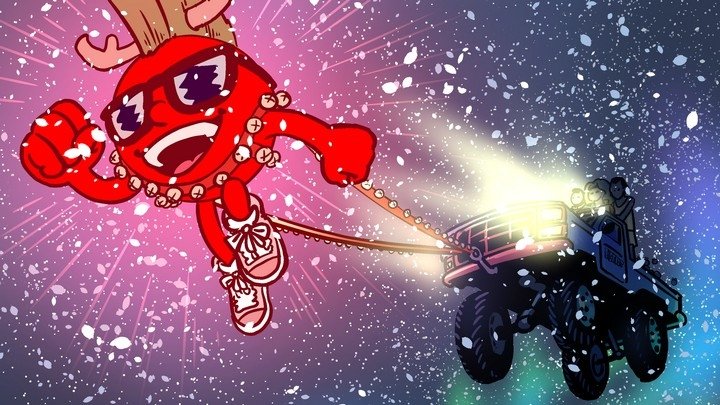Namco Museum for Switch review: Return of the king
Familiarity doesn't always breed contempt, as Namco's excellent new collection of old standards demonstrates.
The idea of classic games compilations more or less died off during the previous console cycle. The advent of digital distribution prompted publishers to explore the a la carte approach to reissuing old games, and long-running compilation series like Namco Museum and Capcom Classics dried up.
There's certainly merit to the idea of buying classics singly. Maybe you just want to play Strider without having to scroll past 1942 to select it. Even so, I can't help but feel that with the disappearance of the retro anthology concept, we lost something precious. Besides the appeal of offering a healthy selection of vintage arcade works in a single package, compilations also provided other benefits. Standalone releases from larger companies generally only happen for notable or popular games, the ones publishers see potential profit in posting individually. Sure, there are exceptions — see the ultra-niche titles that comprise Hamster's Arcade Classic Archives series on PlayStation 4 and Switch — but when it comes to larger publishers, forget about it. Capcom will happily repackage Street Fighter II, because that will sell. But don't hold your breath for a standalone rendition of, say, Three Wonders or even Magic Sword.
Fortunately, the tide seems to be turning slowly back in favor of the compilation concept. We've seen a handful of anthologies in recent years — SEGA's 3D Classic Collection for 3DS, and Capcom's Mega Man and Disney collections (the most recent of which launches today) — and the recent release of Namco Museum for Switch means Namco has skin in the game again as well.

All of these releases have one important thing in common: They speak to a different mindset than the compilations of the ’90s and ’00s. None of them have the low-grade shovelware feel that afflicted so many older collections. They all clock in at a budget-friendly price. They feature thoughtful display options, save states, and online features. They aren't simply a bunch of ROMs slapped into an emulation wrapper; they feel considered. Meaningful.
Admittedly, this new Namco Museum lacks the elaborate visual metaphor that gave the series its name in the first place. The first five (six if you count the Japan-only "Trademark" volume) PlayStation Namco Museum collections dropped players into a virtual museum environment, a 3D space in which you could wander and look at the games as if they were part of an exhibition. There was even a robot receptionist to guide you around. That element has long since disappeared in Museum releases in favor of a quick, no-nonsense menu system. Even thosee loving stacks of supplemental artwork and commercials have evaporated.
This ultimately just reflects a change in focus over time. Those ’90s embellishments have become moot, charming as they were at the time. There's no longer much charm or appeal in wading through a 3D space to get at a game menu — polygons are a simple fact of gaming, not a magnificent next-generation novelty. Meanwhile, the company would have to spelunk into the depths of its archives to find promotional material that hasn't already been chronicled on various fansites and wikis in the 20-plus years that have transpired since the first Namco Museum made its debut.
Instead, Namco Museum for Switch places the bulk of its creative efforts on the game experience itself. Every title compiled here offers a wealth of display options, far more than we're used to seeing in official compilations. You can choose from several pixel-perfect (or not) scaling options; incorporate optional scanlines across 20 steps of intensity; and wallpaper the dead space onscreen with cabinet art, pixel-arts patterns, or neutral grey. More importantly, Namco has capitalized on the fact that the heart of Switch consists of a self-contained screen with detachable controllers. As with a handful of other retro releases for Switch (such as last week's conversion of Psikyo's Strikers 1945 Pt. II), you can play games that originally ran on vertical monitors with the Switch propped up vertically — to my knowledge, the first time that's been reasonably possible on a classics compilation for a console system. Playing Galaga or Pac-Man "sideways" with the graphics filling most of the Switch screen alone is worth the price of admission for this collection, in my opinion.

Namco Museum includes several other well-considered details to justify its existence, too. For example, Tower of Druaga — an infamously obtuse action-RPG based around the idea of requiring players to perform increasingly unintuitive actions in order to acquire essential treasures — carries over the level-by-level hint feature from the little-loved Namco Museum DS. You can also choose to start a new game from any level of the tower you've already reached, with all treasures carried forward. That's in addition to the save states and multiple difficult options featured for each game.
While purists might balk at the idea of being able to mitigate the difficulty level of these old games by saving progress or setting imaginary dipswitches to churn out extra lives, those tweaks come with a limitation. If you "cheat" to make a game easier for yourself, you lock yourself out of the online leaderboards for that game until you revert the settings back to the default. In other words, you can enjoy the game however you like, but the competitive experience requires a level playing field.
This Namco Museum does feature a few odd choices. For some reason, you can only play the Japanese versions of Rolling Thunder 2 and Tank Force, so the localized text for those games doesn't appear as part of the games but rather as a subtitled overlay. This may be a reflection of the fact that Namco Museum shipped as a single worldwide release (rather than being tweaked for separate release in specific regions); those games were only ever released in Japan and the U.S., so European localizations would have to appear as subtitles no matter what. It's still strange that Namco didn't include the U.S. versions, though. Another minor frustration: While you can customize button configurations, you can't remap directional controls — something that would come in handy from time to time, especially in Pac-Man.
On the whole, though, Namco Museum does a great job of preserving and reproducing nearly a dozen different games, some of which have never appeared in a home collection before. The emulation framework reportedly runs on Unity, but after hours of play across all the games, I haven't noticed any visual glitches, audio issues, control lag, or frame-dropping. Every game runs smoothly and faithfully. I've noticed that the front-end for menus and options very occasionally lags for a split-second, but it's a minor issue and doesn't affect the most important part of the collection (the games themselves).

As for the overall collection of games here, well, it showcases the value of compilations versus individual releases. I sincerely love the selection of arcade titles Namco assembled for this package, because it hits a wide spectrum of interests: All-time classics, cult favorites, and genuine obscurities. I've only ever heard of Tank Force in passing, and I have trouble imagining the company ever going to the trouble of giving that game — essentially a fancy, latter-day version of Atari's Combat — a standalone release. But here it is, sneaking its way into people's library by kiting along behind Pac-Man, and it turns out to be a fun albeit shallow little war game.
The full list of titles included in Namco Museum for Switch:
- Dig Dug
- Galaga
- Galaga ’88
- Pac-Man
- Rolling Thunder
- Rolling Thunder 2
- Sky Kid
- Splatterhouse
- Tank Force
- Tower of Druaga
I have seen quite a few complaints in forums and social media that this Namco Museum includes too many games that have already been reissued ad nauseum, an attitude I can't say I fully agree with. In what universe does it somehow work to our detriment to have access to Galaga on a new game system? Sure, we've seen Dig-Dug and Pac-Man on practically every platform to make its way to market since the Atari 2600, but they're foundational works. They deserve, and need, to remain in circulation. If only every publisher were so thoughtless as to keep their masterpieces readily available for play at reasonable prices in a variety of formats.
The other major criticism frequently being directed at Namco Museum for Switch concerns its price: It's a digital-only release collecting 11 games selling for $30. I never like to presume to tell people what's worth it or not, because a monthly gaming budget for someone living on $24,000 per year is very different than the budget of someone making $80,000. I will say, however, that the price-per-game works out to be more than a dollar less than these games sell for individually on the PlayStation or Xbox digital storefronts... not that you can buy Rolling Thunder 2 or Tank Force on those services.

I personally find the number of different games included here to be perfect. Again, these 11 titles cover a full spread of genres, popularity, and even dates (spanning from 1980 to 1991, Pac-Man Versus not included). With just shy of a dozen titles to pick from, Namco Museum allows you to skip over a game or two you find unpalatable without feeling like the collection contains too much dead weight. At the same time, you also avoid the "ROM list" effect that comes with compilations that include dozens upon dozens of games. Who actually played every single game in Sonic's Ultimate Genesis Collection? Whereas here, the modest, well-curated title list encourages players to at least experiment with unfamiliar releases. You'll probably find yourself sliding right past Tower of Druaga, since you're not a Japanese kid with access to only a tiny handful of Famicom games in the year 1985, but you're more likely to at least try it here than you would in a collection of 50-plus titles.
Finally, there's the one oddball outlier of the collection, the 11th title: Pac-Man Versus. Based on the hybrid GameCube/Game Boy Advance game from 15 years ago, Versus is slightly odd in that it's a multiplayer game that can't be used on a single Switch. That would seem to fly counter to the point of the Switch and its kickstand-multiplayer design, but it ties back to the asymmetrical nature of the game: One player controls Pac-Man with a full view of the maze, while everyone else controls a ghost and can only see a tiny portion of the action. The game wouldn't work on a single screen, so you need to team up to play with at least one other person who owns a Switch. Still, being able to play with just two Switches (as opposed to a GameCube, some GBAs, and a small viper's nest of cables) demonstrates once again that Pac-Man Versus was a concept that arrived just a little too soon for its time.
With this collection, Namco has joined the ranks of publishers who recognize Switch's brilliance as a classic games machine. Hopefully Nintendo will get the clue one of these days, too. Namco Museum shows off the versatility of Switch, covers a valuable and interesting cross-section of Namco's history, and does a great job of presenting the games in question both in technical terms and with some great extras (besides those leaderboards and essential Druaga tips, there are also special challenges to take on for each game). If this release heralds the return of the classic arcade compilation as a force in gaming, it makes a convincing case for it.




